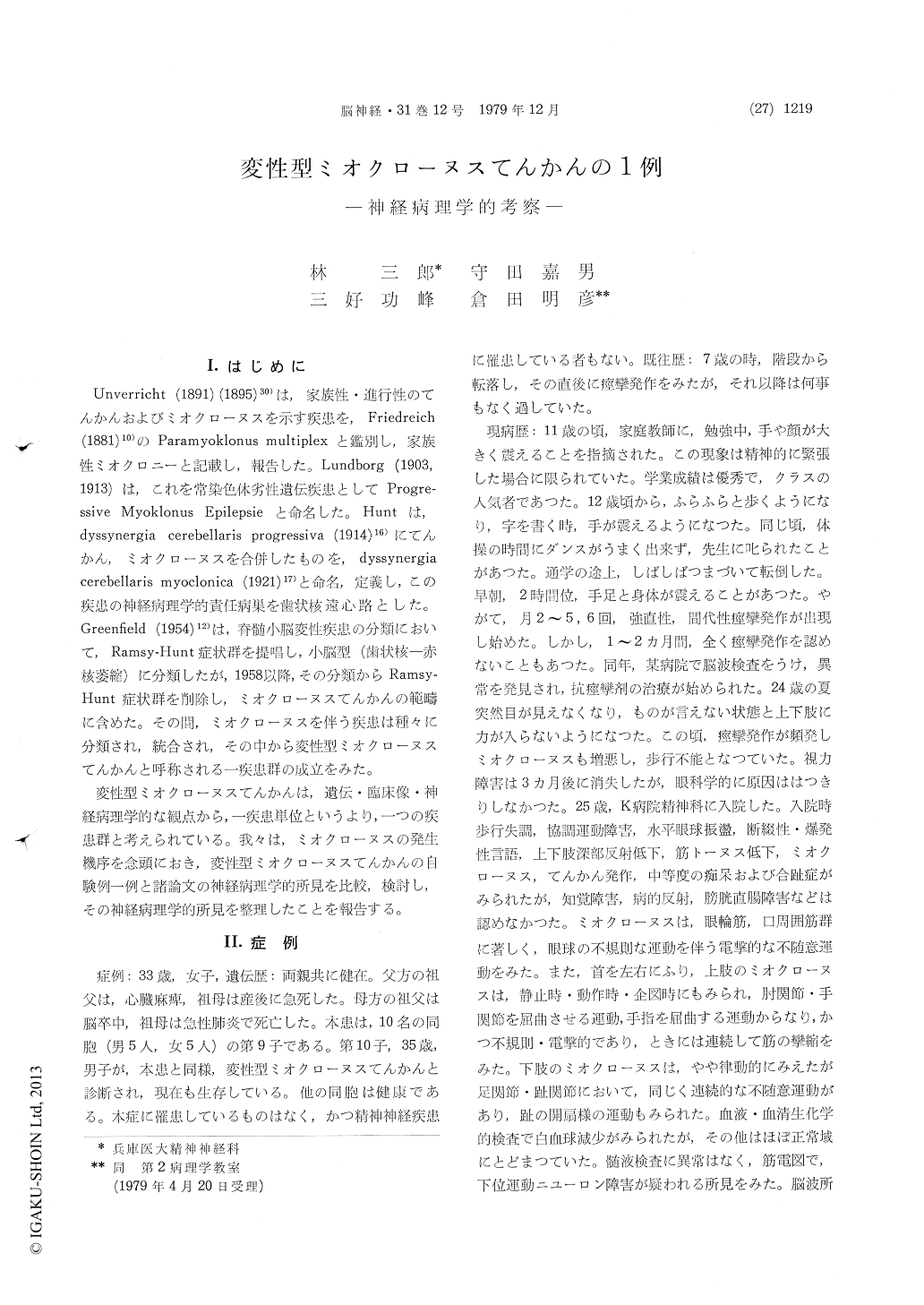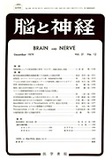Japanese
English
- 有料閲覧
- Abstract 文献概要
- 1ページ目 Look Inside
Ⅰ.はじめに
Unverricht (1891)(1895)30)は,家族性・進行性のてんかんおよびミオクローヌスを示す疾患を,Friedreich(1881)10)のParamyoklonus multiplexと鑑別し,家族性ミオクロニーと記載し,報告した。Lundborg (1903,1913)は,これを常染色体劣性遺伝疾患としてProgre—sslve Myoklonus Epilepsieと命名した。Huntは,dyssynergia cerebellaris progressiva (1914)16)にてんかん,ミオクローヌスを合併したものを,dyssynergiacerebellaris myoclonica (1921)17)と命名,定義し,この疾患の神経病理学的責任病巣を歯状核遠心路とした。Greenfield (1954)12)は,脊髄小脳変性疾患の分類において,Ramsy-Hunt症状群を提唱し,小脳型(歯状核—赤核萎縮)に分類したが,1958以降,その分類からRamsy—Hunt症状群を削除し,ミオクローヌスてんかんの範疇に含めた。その間,ミオクローヌスを伴う疾患は種々に分類され,統合され,その中から変性型ミオクローヌスてんかんと呼称される一疾患群の成立をみた。
変性型ミオクローヌスてんかんは,遺伝・臨床像・神経病理学的な観点から,一疾患単位というより,一つの疾患群と考えられている。我々は,ミオクローヌスの発生機序を念頭におき,変性型ミオクローヌスてんかんの自験例一例と諸論文の神経病理学的所見を比較,検討し,その神経病理学的所見を整理したことを報告する。
Myoclonus epilepsy of degenerative form is con-sidered not to be an established disease entity, because of variety and diversity of symptomatology and pathological findings. Myoclonus epilepsy of degenerative form in the point of neuropathology, although those findings are so far varied and diverse, has generally stressed dentato-fugal degen-eration, dentate degeneration and olivary degener-ation.
Author viewed with our case of myoclonus epilepsy of degenerative form, compared with other pathologically studied in the literature. The patient was a single woman aged 33 years. She was the ninth of ten siblings. Her younger brother in the same way suffered from myoclonus epilepsy of degenerative form and is still alive. Her parents and other siblings are living and well. At the aged of 11, she showed trembling in the hand and the face, at that time, she was a good student and well. At the aged of 12, she revealed ataxic gait and intention tremor. Soon she showed epileptic convulsion and was treated by anticonvulsant therapy. She also manifested myoclonia. At the aged of 24, she experienced the sudden attack of transient amaurosis, speech difficulty and weakness of the limbs. Later, she gradually showed inability to walk. At the aged of 25, she was admitted to K. Univ. hospital. On admission, neurological manifestation revealed gait ataxia, incoordination, horizontal nystagmus, slurred speech, diminish of deep tendon reflex, hypotonia of muscle, myoclonus, epilepsy and dementia of moderate degree. Myo-clonus was observed all over the body, especially in the upper extrimities and the face. After a year she discharged from the hospital. At the aged of 33, she was again admitted to the H. M. College hospital. Her conditions were aggravated.She gradually manifested difficulty of swallowing and emaciation. She died of pulmonary edema (rectal ulcer, thrombophlebitis) at the aged of 33 years.
Neuropathologically, the brain weighed 1060g. The cerebellum grossly showed atrophy. Histo-logically, diffuse neuronal depopulations with microglial proliferation were predominantly seen in the parietal and occipital cortex. The large motor cells, such as the Betz cells, showed central chromatolysis. Fibrous gliosis was seen in Ammon's horn, external margin of the putamen, medial medullary lamina of the globus pallidum and external margin of the substantia nigra, with sparing of those neurons. The superior cerebellar pedunculus and the red nucleus were spared. The tegmentum pontis showed fibrous gliosis.
Massive loss of Purkinje cells, with gliosis in the molecular layer, were seen in the cerebellar cortex except the flocculus. Rarefaction and fibrous gliosis revealed in the granular layer. Demyelination and fibrous gliosis were found in the region of the dentate nucleus. The dentate nucleus itself was altered. In the medulla oblangata fibrous gliosis was seen in the posterior funicular nucleus, the medical lemniscus and the inferior olivary nucleus. The inferior olivary nucleus was degenerated.
In the spinal cord central chromatolysis was seen in the anterior horn cells and fibrous gliosis showed in the grey matter. Demyelination and gliosis were seen in the fasciculus gracilis from cervical region to thoracic region and were also seen in the lateral funiculus only in the thoracic region.Fibrous gliosis was also found in the fasciculus cuneatus. Those findings in the spinal cord were discontinuous and non-systemic changes.
Author viewed 53 cases of myoclonus epilepsy of degenerative form, compared with our case and other pathologically studied cases in the literature. From neuropathological point of view the main responsible system lesion of myoclonus epilepsy of degenerative form can be summerized as follows (roughly in that order of frequency); 1) cerebello-olivary degeneration, 2) Dentatofugal degeneration, 3) Dentate degeneration.
In general, a reciprocal relationship exits between them. Among myoclonus epilepsy of degenerative form a small number of cases show localized lesion (pure form). They may be enumerated as follows (roughly in that order of frequency); 1) anterior horn degeneration, 2) inferior olivary degeneration, 3) cerebral cortical degeneration, 4) cerebellar cortical degeneration, 5) cerebello-olivary degener-ation (Holmes).
Although a reciprocal relationship exits between them, one of them combined other main system lesion may be enumerated as follows (roughly in that order of frequency); 1) combined cerebral cortical degeneration, 2) combined anterior horn degeneration, 3) combined tegmetum degeneration, 4) combined posterior funiculus degeneration, 5) combined basal ganglia degeneration.
The neuropathological view of myoclonus epilepsy of degenerative form, compared with our case and other cases in the literature were briefly discussed.

Copyright © 1979, Igaku-Shoin Ltd. All rights reserved.


